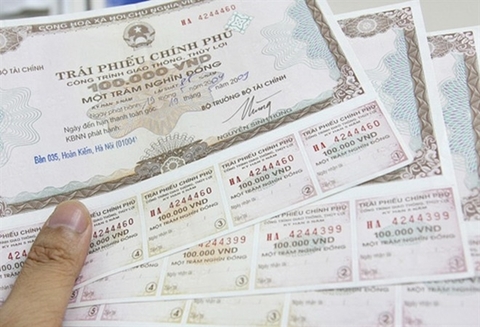Local bond market reaches US$55 billion in nine months
Local bond market reaches US$55 billion in nine months
Vietnam continued to have the smallest local currency (LCY) bond market in emerging East Asia, with outstanding bonds of VND1.2777 quadrillion (US$55.1 billion) at the end of September, said the Asian Development Bank in its latest Asia Bond Monitor report.
The report said that the overall growth of the LCY bond market accelerated to 3.4% quarter-on-quarter in the third quarter of this year from 2.6% in the previous quarter.
The gain was solely driven by government bonds as corporate bonds posted a quarter-on-quarter decline. On a year-on-year basis, total bonds outstanding grew by 1.9% year-on-year.
As of late September, the outstanding stock of LCY government bonds climbed to VND1.1725 quadrillion, growing 4% quarter-on-quarter after rising 3.2% quarter-on-quarter in quarter two.
The bulk of the quarter-on-quarter growth was driven by significant gains in central bank bills, which expanded 118.2% quarter-on-quarter in quarter three, while treasury bonds only grew 0.9% quarter-on-quarter.
Government-guaranteed and municipal bonds, on the other hand, contracted 1.7% quarter-on-quarter. On a year-on-year basis, total government bonds grew 1.7% in quarter three.
Treasury bonds remained the largest contributor to the stock of government bonds, accounting for an 80.2% share at the end of quarter three.
Total outstanding treasury bonds reached VND940.8 trillion in late September. Growth in the government bond stock was capped by a decline in planned issuance by the State Treasury of Vietnam during the quarter.
In August, the number of auctions was down from weekly to once every two weeks. While the amount of outstanding central bank bills grew a significant 118.2% quarter-on-quarter to VND72 trillion, growth moderated from 573.5% quarter-on-quarter in quarter two. Growth in central bank bills also declined 4% year-on-year.
The outstanding amount of LCY corporate bonds fell 2.8% quarter-on-quarter in quarter three to VND105.2 trillion. On a year-on-year basis, however, corporate bonds grew 4.2%.
AsianBondsOnline data on corporate bonds in Vietnam showed that the entire corporate bond market comprised 45 institutions. Many corporates in Vietnam issue bonds through private placements in which information is mostly undisclosed.
The aggregate bonds outstanding of the 30 largest bond issuers in Vietnam amounted to VND101.1 trillion, accounting for 96.1% of the corporate bond total at the end of September.
In the top spot was Vinhomes, a subsidiary of the country’s leading private conglomerate Vingroup, with outstanding bonds of VND12.5 trillion, followed by Masan Consumer Holdings at VND11.1 trillion. Vingroup, which previously held the top spot, dropped to the third spot at VND10.1 trillion.
Together, the top three firms accounted for 32% of the corporate bond total. The top 30 list was dominated by firms from the banking and real estate sectors. Of the list, four are State-owned firms and 20 are listed with the Hanoi Stock Exchange.
Bond yields down
Vietnam’s LCY government bond yield curve shifted downward between August 31 and October 15, according to the report.
Bond yields for all tenors fell, with yields shedding an average of 26 basis points across the curve. The five-year tenor and 15-year tenor declined the most at 38 basis points each.
Yields generally fell more at the longer end than the shorter end of the curve, leading to a narrowing of the two-year versus 10-year yield spread from 126 basis points in late August to 118 basis points in mid-October.
The downward yield movement was driven largely by a policy rate cut by the State Bank of Vietnam (SBV) on September 13.
The SBV reduced its key policy rates by 25 basis points each, bringing the refinancing rate to 6%, the rediscounting rate to 4% and the overnight rate to 7%.
Unlike other central banks in the region, the SBV’s move was largely in response to easing monetary policies in advanced economies as opposed to declines in domestic growth.
The SBV cited the negative developments in the global economy and easing monetary policy in the United States and the European Central Bank and noted that the domestic economy remains stable with inflation under control.















